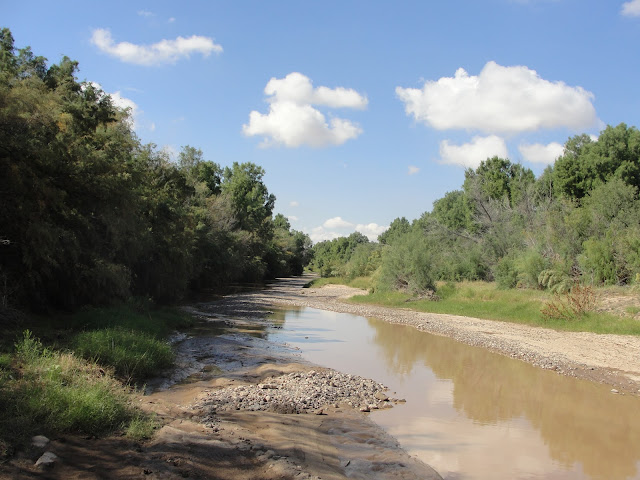SANTA CRUZ FLATS—A GREAT PLACE FOR BIRDING
By Doug Jenness
 |
| Crested Caracara in the Flats, Lois Manowitz |
Many non-birders likely think that birding must take you to pristine forests and cool, fast-running brooks. This is certainly true, but that’s not the whole story. We also spend a lot of time at sewage plants, dairy sludge ponds, feedlots, and farm fields. Why? Because that’s where a lot of interesting birds are! One of the more popular such sites is the Santa Cruz Flats, a broad flat agricultural area of roughly 350 square miles between Tucson and Casa Grande, where 274 species of birds have been reported. It is located in Pinal County west of the small town of Red Rock and is comprised of many acres of cultivated crops, sod farms, pecan groves, a cattle feedlot, a dairy farm, and a sheep farm, all intersected by a labyrinth of irrigation ditches and canals and dotted with temporary and permanent ponds.
Before the Santa Cruz Flats was settled by farmers in the late 1800s, much of the land was dominated by Sonoran savannah grasslands, where native grasses were a couple of feet high and grassland fauna could be found, including pronghorn, jackrabbit, and even White-tailed Hawk. The course of the Santa Cruz River was different than it is now. It periodically flooded, spreading out over the flat land. Water still runs intermittently in the Santa Cruz River and its diversion canals, mostly due to fluctuating flows from Tucson’s water reclamation facilities.
 |
| Santa Cruz River in the Flats, Doug Jenness |
 |
| Fields of globemallow, Doug Jenness |
Irrigation water in ditches, canals, ponds, flooded fields, and sod lawns draw a wide diversity of wintering waterfowl, shorebirds, and waders to the Flats. A big draw for birders is Mountain Plovers, which may be found at the sod farms from September through March. In recent years, they have been most reliably reported at the Evergreen Turf sod farm. Other plovers, including Pacific Golden-Plover, American Golden-Plover, and Black-bellied Plover have also been recorded at least once. Individual Upland Sandpipers have been reported twice.
Many observers were fortunate to see Pinal County’s first record of White-rumped Sandpiper in May 2016 at a small, temporary farm pond. Rarely reported in the county, a Ruff showed up in a flooded field in 2010 and a Whimbrel in 2011. A Roseate Spoonbill made a brief showing in 2012 at a floodwater containment pond.
 |
| Mountain Plover, bryanjsmith |
Many grassland species of sparrows as well as pipits winter in the area. Sagebrush Sparrows, found in the extensive saltbush flats in the western part of the area, are a favorite of birders. In early 2015 a few Sprague’s Pipits were discovered in the Bermuda grass fields adjacent to Evergreen Turf, and up to six have been reported in the two winters since. Three species of longspur have been occasionally reported at or near Evergreen Turf.
Many birders visit the Flats in the winter to observe the large number of raptors that winter or migrate through the area. Particularly notable is the influx of socially foraging, nonbreeding Crested Caracaras beginning in November and continuing through April. Although caracaras have been reported erratically from the Flats since 1965, their numbers in winter have dramatically increased in the past decade. A total of 25 raptor species have been reported during the winter, including six species of owl. Not seen in winter, Swainson’s Hawk migrates through the area in spring and fall, with large flocks often numbering more than 100 birds.
In addition to the farm fields interspersed with desert scrub, there are a few riparian corridors dominated by Gooding’s Willow and tamarisk that attract breeding birds such as Yellow-breasted Chat, Bell’s Vireo, and Lucy’s Warbler as well as many migrants. Such state rarities as Louisiana Waterthrush, Palm Warbler, and Black-throated Green Warbler have been reported. Farm yards with shrubbery and nut and fruit trees have attracted vagrants, including rarities, such as Rufous-backed Robin and Black-throated Blue Warbler.
 |
| Swainson's Hawk, Martin Molina |
 |
| Sagebrush Sparrow, Scott Olmstead |
Over a dozen years ago Ruddy Ground-Dove was reported regularly in the vicinity of the Red Rock feedlot. A nest along the Santa Cruz River at the Sasco Rd. ford in 2006 was the first documented north of Mexico. In recent years, however, this dove has been sparse with none reported some years. Particularly intriguing is the discovery of many nesting pairs of Tropical Kingbirds. This kingbird had been casually reported in the area since the late 1990s, but it wasn’t until 2013 that nesting was confirmed in single rows of pecan trees along roadsides, principally in the Baumgartner Road/Wheeler Road area. As many as 15-20 pairs have been detected nesting.
Paradise Lake, an artificial lake in the town of Arizona City at the northern end of the Santa Cruz Flats, has hosted many rarities, including both Brown and American White pelicans, Common Loon, Heermann’s Gull, and Horned Grebe, as well as many other water-birds.
 |
| Tropical Kingbird, Ned Harris |
 |
| Brown Pelican, Lois Manowitz |
The Santa Cruz Flats can be accessed from five exits on I-10: Red Rock (Exit 226), Picacho (Exit 212), Sunshine Road (Exit 208), Toltec Highway (203), and Sunland Gin Road (Exit 200). Details about getting to the sod farms and other locations are included in Finding Birds in Southeast Arizona, published by Tucson Audubon.
Doug Jenness is a long-time activist in Arizona Field Ornithologists, coordinator of the annual Santa Cruz Flats Raptor Count, and author of articles on Crested Caracaras and Tropical Kingbirds for Arizona Birds.
Comments
Post a Comment
Thanks, we value your opinions! Your comment will be reviewed before being published.